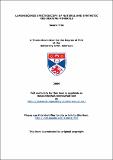Files in this item
Luminescence spectroscopy of natural and synthetic REE-bearing minerals
Item metadata
| dc.contributor.advisor | Finch, Adrian Anthony | |
| dc.contributor.advisor | Donaldson, C. H. | |
| dc.contributor.advisor | Williams, C. T. | |
| dc.contributor.author | Friis, Henrik | |
| dc.date.accessioned | 2009-10-02T10:52:09Z | |
| dc.date.available | 2009-10-02T10:52:09Z | |
| dc.date.issued | 2009-06-25 | |
| dc.identifier.uri | https://hdl.handle.net/10023/756 | |
| dc.description.abstract | This study investigates the photoluminescence (PL), cathodoluminescence (CL), radioluminescence (RL) and ionoluminescence (IL) of natural and synthetic minerals. The natural minerals (fluorapatite, leucophanite, meliphanite and zircon) are mostly from Ilímaussaq Alkaline Complex in South Greenland, Langesundsfjord in Norway and from different localities within Scotland. Synthetic fluorapatite (manufactured as part of the present study) and zircon doped with rare earth elements (REE) were used to compare single and multidoped materials. This study has shown that many of the generally accepted applications of luminescence are not as straightforward as often suggested by the current literature. For example, the study demonstrates how site distribution of REE, based on luminescence, is greatly affected by the dopant level and structural changes, and that different conclusions can be drawn on the same sample depending on method applied. Furthermore, it is clearly demonstrated that using luminescence as a tool for quantitative trace element determination is not going to be a standard technique in the near future if ever. The two main findings supporting this conclusion are the non-linear intensity decrease between different REE activators in the same sample and a large variation between activators at the concentration at which self-quenching starts. In contrast to the general perception that luminescence related to REE is mostly independent of the host, this study has shown a strong interaction between host and REE activators. This conclusion is supported by the change in the activator’s coordination polyhedron observed with single-crystal and powder X-ray diffraction combined with full chemical characterisation. When combining the weak interaction between some REE with the strong host interaction this study has shown the potential for designing new types of colour tuneable and “white light” LEDs based on natural minerals. This study also reveals that zircon doped with Gd³⁺ and Eu³⁺ can potentially have quantum-cutting properties. | en |
| dc.format.extent | 2675 bytes | |
| dc.format.mimetype | application/pdf | |
| dc.language.iso | en | en |
| dc.publisher | University of St Andrews | |
| dc.subject | Photoluminescence | en |
| dc.subject | Cathodoluminescence | en |
| dc.subject | Radioluminescence | en |
| dc.subject | Ionoluminescence | en |
| dc.subject | Apatite | en |
| dc.subject | Zircon | en |
| dc.subject | Beryllium | en |
| dc.subject | Lanthanides | en |
| dc.subject | Crystallography | en |
| dc.subject.lcc | QE369.S65F8 | |
| dc.subject.lcsh | Luminescence spectroscopy | en |
| dc.subject.lcsh | Rare earths--Analysis | en |
| dc.subject.lcsh | Luminescence | en |
| dc.title | Luminescence spectroscopy of natural and synthetic REE-bearing minerals | en |
| dc.type | Thesis | en |
| dc.type.qualificationlevel | Doctoral | en |
| dc.type.qualificationname | PhD Doctor of Philosophy | en |
| dc.publisher.institution | The University of St Andrews | en |
| dc.publisher.department | Natural History Museum, London | en |
This item appears in the following Collection(s)
Items in the St Andrews Research Repository are protected by copyright, with all rights reserved, unless otherwise indicated.

